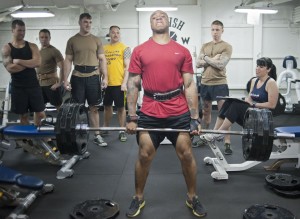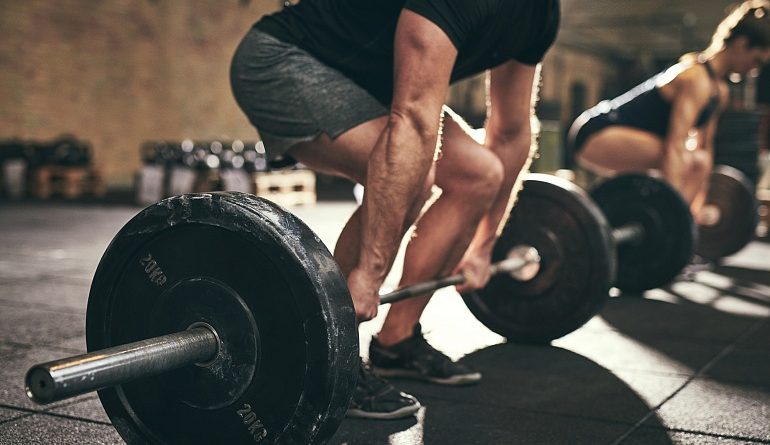Back pain after the deadlift or squat – do I have to see a doctor?
Highly complex full-body exercises such as deadlifts or squats can lead to excellent results in muscle building, at least if these demanding exercises are performed correctly and cleanly. If …
Because anyone who works with an unclean technique when doing squats or deadlifts, or constantly pushes too many weights on the barbell – and this practice is commonplace in most fitness studios, will soon be various search engines with their regular search queries annoy the subject of back pain and joint pain after the deadlift. But let’s start at the beginning: Where does the back pain come from?
Is the deadlift bad for your back?
It all depends. Exercises like deadlifts are, and this also applies to squats, an extremely complex compound exercise, in which not only a primary muscle group is stimulated in isolation, but a whole series of muscle groups are intensively stressed. In squats and deadlifts, the lower back muscles, core muscles (lateral, transverse and straight abdominal muscles) as well as the quadriceps in the thigh are “victims” of this outstanding stimulation and lead to excellent muscle hypertrophy – provided that the technique is correct.

This enormous hypertrophy effect on the muscles is often “bought” by the high level of complexity in the execution. In the case of deadlifts and squats, this means nothing other than: high risk of injury! Even small deviations in the vertical “ideal line” in which the barbell has to be held can injure the spine, joints or Ligaments and muscles cause.
In order to avoid injuries when deadlifting or “squatting”, not only beginners should heed the following points. This can at least minimize the risk of injury:
- The right technique for cross-bending and squats: If you dare to do deadlifts and squats, you have to master the right technique. In these videos, deadlifts and squats are explained very clearly.
- Warm-up and exhaustion: Anyone who has already warmed up the lower back muscles, abdominal muscles and thighs through various exercises before the deadlift or the squat and thus triggers pre-exhaustion, benefits not only from increased blood circulation (better supply of nutrients) and a warmed up joint apparatus, but can (better said: must) also train with lower weights. This greatly reduces the risk of injury.
- Regular control: In the course of training, advanced athletes often automatically develop their own technique that adapts to personal physiological limitations or circumstances (e.g. shortened tendons, limited immobility or slight illnesses / restrictions in the musculoskeletal system). As a rule, the athlete does not notice this adjustment. Therefore, regular control of the execution of the exercise by qualified personnel or experienced athletes (e.g. trained fitness trainers or professional strength athletes) is advisable.
- Choose your weights wisely! Sure – Heavy weights look great, especially when they pile on your barbell. Just keep in mind that you only have one spine. Even if medical technology is now quite advanced, there are only a few really helpful and gentle treatment methods for acute injuries to the spine.
Spinal stenosis: common cause of back pain
An unusual load on the spine is often enough to trigger typical symptoms of a back disease. For example, regular deadlifts or intense squats, in spite of the correct technique, can additionally intensify the symptoms caused by a genetic or age-related and wear-related spinal stenosis or even make them “visible” in the first place. But what causes this unexplained back pain and how can it be treated?
What is spinal stenosis?
This unwieldy word primarily describes the narrowing (stenosis) of the canal along the spinal column, in which the spinal cord and nerve cords also run (spinal canal) . The canal, also known colloquially as the “spinal canal”, can be compressed by various mechanical influences and thus exerts physical pressure on the nerve cords and the spinal cord running through it. Depending on the degree of compression, this condition can cause mild to severe back pain, which can also radiate into the limbs.
Causes of a spinal canal narrowing
The main reason for a stenosis of the spinal canal are mechanical influences such as (age-related) wear (degeneration) and physical overload of the spine (e.g. from heavy physical work or excessive strength training). But osteoporosis, lack of exercise or genetic predisposition can also trigger, intensify and increase the symptoms typical of a narrowing of the spinal canal chronic back pain cause.
Over the years, the intervertebral discs often continuously lose stability and the intervertebral disc tissue can no longer optimally store water. This loss of volume leads to a reduction in the height of the intervertebral discs and the damping capacity between the vertebral bodies and thus causes more play between the vertebral bodies in the long term, which makes the spine more susceptible to wear and tear from physical impact . The loss of volume of the intervertebral discs can also lead to reduced elasticity in the vertebral area because the ligaments running along the spinal column are less taut.
The body’s natural organic regeneration process tries to maintain the distance between the vertebral bodies, however, and forms bony outgrowths on the vertebrae and joints, which should avoid direct contact between the vertebral bodies. However, this natural hypertrophy can aggravate the symptoms of spinal stenosis if the irregular growths increase the pressure on the spinal canal and thus pinch the spinal cord or nerve cords.

Symptoms of spinal stenosis
Typical symptoms of a narrowing of the spinal canal are not particularly characteristic and usually occur. does not suddenly appear, as e.g. This is the case with lumbago (lumbago), but develop slowly over a period of several weeks or even months. A lumbago is still a classic symptom of back pain caused by a narrowing of the spinal canal , because the pain, depending on the degree of narrowing, also affects the thighs, the trunk area and partly can also radiate into the rest of the upper body if the corresponding nerve cords are affected by pressure.
Further symptoms of mild spinal stenosis are e.g.
- Muscle tension in the lower spine or lumbar area
- Significant restriction of movement of the lumbar spine, which can only be overcome with mild to severe pain
- Pain when standing or walking for long periods of time (straightened back). As soon as the back comes into a bent position, e.g. is the case when sitting or cycling, the feeling of pain subsides and almost complete relaxation occurs. The spinal canal widens in a bent position and thus reduces the pressure on the nerves and the spinal cord
- Numbness or sensory disturbance down the lumbar spine (e.g. in the legs), as well as decreasing muscle tension or even disturbances in sexual function already indicate severe cases of spinal stenosis and should urgently be treated by a specialist
Treatment options for back pain from spinal stenosis
Should the attending physician find an acute risk or restriction in the patient due to the symptoms described, classic diagnostic methods such as magnetic resonance tomography or computer tomography are usually used to localize the areas affected by the narrowing.
Depending on the complexity of the spinal canal stenosis , there is a multitude of possible non-surgical and minimally inverse and extensive surgical treatment methods.
When diagnosing a slight constriction of the spinal canal, stability-promoting therapeutic measures such as physiotherapy or physiotherapy, which aim at the targeted build-up of muscle mass in the area of the vertebral and lumbar spine, are often sufficient. In this way, conventional, not arrogant strength training with deadlifts and other compound exercises can also promote muscle building in the back and be used as a useful therapeutic measure. In this case, however, the affected patients should be cared for by specialist staff in order to rule out further damage from incorrect training or overload.

Surgery should only be considered if symptoms do not resolve significantly with medical treatment. One of the many possible treatment methods is the newly developed and minimally invasive iLESSYS ® procedure. As a provider of medical technology, joinmax has among others Specialized in the field of spinal surgery and can use the procedure to treat spinal stenosis in a targeted manner by creating direct access to the spinal canal through an incision only a few millimeters long along the spinal column, through which the excess tissue or bony outgrowths can be removed.
As a rule, this procedure damages very little substance on the bones and ligaments and the muscles and connective tissue can simply be pushed to the side. Thus, a light anesthetic is usually sufficient for this surgical procedure and the patient’s regeneration time is minimized. So you can soon start your everyday life again without pain.
Note: This article cannot replace medical advice from a specialist and only represents possible treatment methods for back pain. In the event of an acute illness, those affected should urgently contact a specialist and receive individual advice and treatment.

